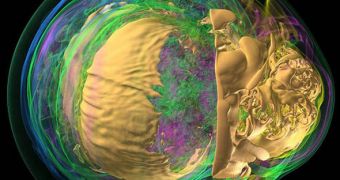Over recent years, the speed at which supercomputers process the datasets they are tasked with has increased so much that it now virtually exceeds the speed at which the computers can input or output this data. This means that graphics-processing clusters are slowly becoming obsolete, as they can no longer improve their performances in terms of overall efficiency. A possible solution, devised at the Argonne National Laboratory in the US, would be to stop employing these clusters, and instead use each single processor to construct an image.
The ANL experts have already taken the first steps towards accomplishing this, when they created an elaborate model of what goes on inside a supernova, created entirely without the use of a graphics clusters. The team wrote a new piece of software, which allows for the thousands of processors in an average supercomputer to do the visualization themselves, without having to send the information to specialized clusters, which are limited by input/output handling performances.
“The bigger we go, the more the problem is bounded by [input/output speeds],” explains ANL computer scientist Tom Peterka, one of the experts who helped write the new software for the IBM Blue Gene/P supercomputer Intrepid. The software allows the team and Intrepid to bypass the graphics-processing cluster entirely. “It allows us to [visualize experiments] in a place that's closer to where data reside – on the same machine,” the expert adds, quoted by Technology Review.
Usually, Peterka underlines, the data obtained from Intrepid is sent to Eureka, which acts as its visual processing unit. Made entirely out of NVIDIA Quadro Plex S4 GPUs (graphics-processing units), this video unit runs at about 111 teraflops (a teraflop is the equivalent of 1 million equations per second). The supercomputer cluster itself runs at 557 teraflops, which makes it the seven-largest such machine operational today. Moving 3D datasets from Intrepid to Eureka is usually a very time-consuming stage of the simulation, and requires a lot of patience to perform. With the new software, this issue is taken out of the picture.
In the new supernova simulation, Peterka managed to obtain 3D images at a max three-dimensional resolution of 89 billion voxels, as in 3D pixels. For these images to be obtained, 32,768 out of Intrepid's 163,840 processing cores were needed. The team also managed to obtain 2D images at resolutions of 4,096 by 4,096 pixels.

 14 DAY TRIAL //
14 DAY TRIAL //